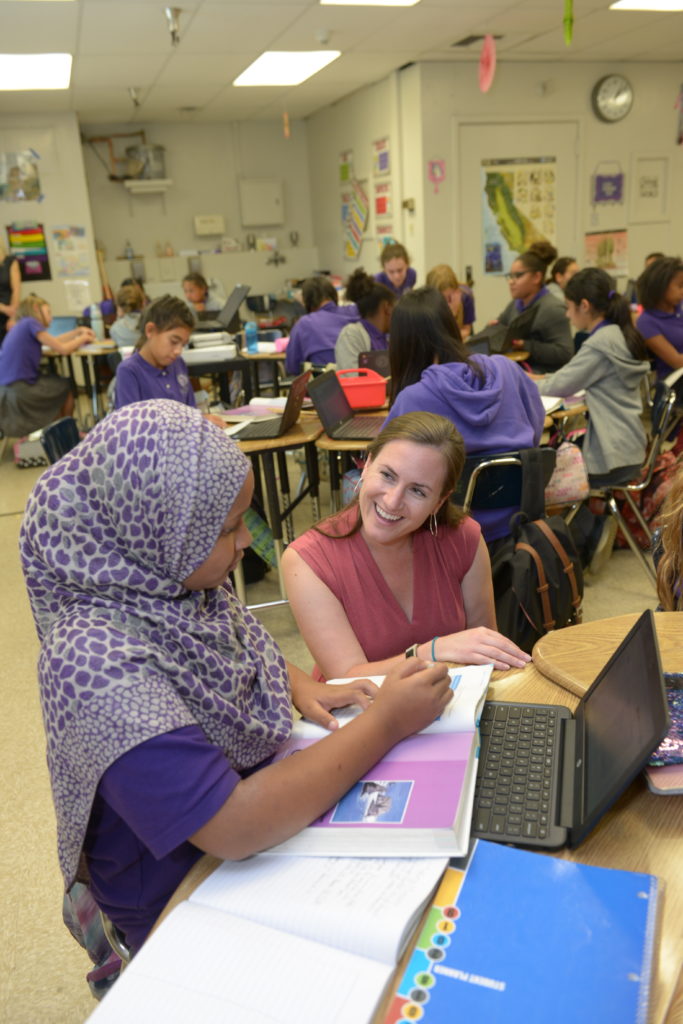
Snap, snap, snap go the fingers of 27 sixth-graders in support of a classmate who offers the correct answer of “carbon” from a corner of the room. In Kelsey McFadden’s class, they’re studying geology today — specifically, how diamonds are formed — and McFadden is about to drop some science. With enough heat and pressure, she says, any carbon-rich material can be turned into diamonds, such as peanut butter or even living things. Wonder-filled eyes open wide as the room explodes with a unified “whoooaaa,” before the girls turn inward to their small groups and excitedly buzz about the possibilities and implications.
The atmosphere doesn’t seem different from any other public school; perhaps a little more focused than usual, but to be fair, it is some pretty cool material. And then what sets it apart from other classes becomes obvious — there are no boys in the classroom. In fact, every student at this school is a girl, but that’s just the beginning of what makes Girls Academic Leadership Academy (GALA) a special place.
“We’re thinking about who these girls are going to be after high school and beyond. Who are the leaders we are building here?”
Kelsey McFadden, GALA Science Teacher, UTLA
Nestled in a corner on the Los Angeles High School campus, GALA (full name: the Girls Academic Leadership Academy: Michelle King School of Science, Technology, Engineering and Math) is the only noncharter, all-girls public school in California and the first ever in Los Angeles Unified School District, which alone would be enough to merit attention. But it’s what founder and Principal Liz Hicks and 22 dedicated educators are doing to provide opportunities to nearly 500 girls in grades six to 11 that makes GALA so special. With a mission of reducing the gender equity gap in high-tech fields like programming and engineering, GALA focuses on rigorous, college-preparatory curriculum in science, technology, engineering and math (STEM).
“A lot of students arrive and are into science, engineering and math but haven’t felt like they had a chance to shine before,” said McFadden, who also serves as the site representative for United Teachers Los Angeles (UTLA).
Brilliant! Our 2018 Innovation Issue

These educators translate ideas, inventions and ways of doing things into something profound and often magical
Tricia Hyun, et al – English teachers find gamification a winner
Dan Frank – Manufacturing student success
Western High’s Link Crew – Program fosters freshman connection
Brandy Peters – Tech educator levels the playing field
Virginia Marshall – Honoring black student achievement
Jessica Husselstein – Hitting just the right note
Jesse Barnett – Students use cameras to get in touch with the world
Rose Borunda – Changing the California Indian
GALA opened its doors to girls from throughout the district in 2016, following years of efforts by Hicks to garner support for her idea. When her daughter earned a scholarship to attend a prestigious prep school, it set the former longtime Hamilton High School teacher on a mission to provide the same outstanding experience to exceptional young women regardless of their economic circumstances — an all-girls public school.
“I thought, ‘Why can’t we do this in public schools?’” Hicks said. “Let’s make sure we do this for our girls in Los Angeles.”
That vision and tireless dedication by Hicks has become a supportive community of nearly 500 students, the oldest of which will be GALA’s inaugural graduating class in 2020. The student body is as diverse as Los Angeles itself, ethnically, economically and socially: GALA students come from 154 elementary schools in 81 ZIP Codes and speak 22 languages at home. About a third are Latina, 28 percent white, almost a quarter African-American, and 11 percent Asian.
“There’s no such thing as a majority here at GALA,” said Monica Henderson, president of the school’s parents’ organization, Friends of GALA. “That kind of culture is uncommon on California campuses.”
An opportunity to be smart girls
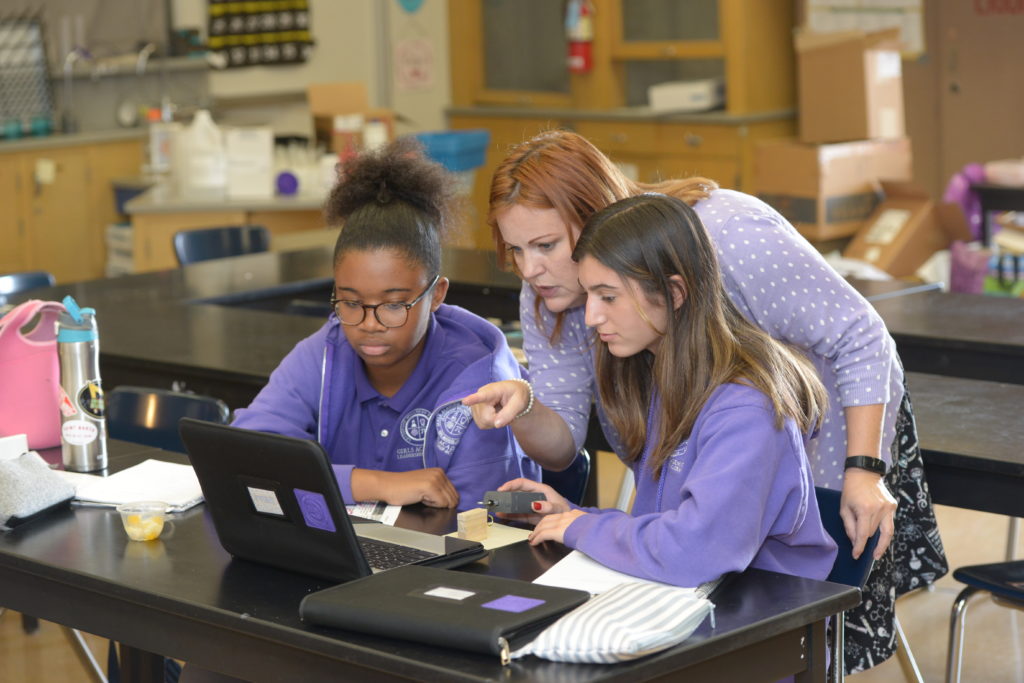
A line on a computer screen bounces along a graph as 11th-graders Manon Abbou and Denielle Parks slowly drag a small block of wood along a piece of sandpaper. Using a wireless device, the girls are measuring friction in Emilie Hill’s AP Physics class. At GALA, every single 11th-grade student is taking AP Physics. For Abbou, the rigorous science emphasis there is new and challenging.
“It’s difficult, but we’re getting there,” she said with a smile and half-hearted chuckle.
According to Hill, data shows that the achievement gaps in STEM subjects begin to widen in middle school, but that gap closes in a single-gender educational environment. Coupled with her own experiences as an adolescent girl interested in science, Hill knows how important this focus can be in nurturing the future women scientists and engineers of the world.
“When I was in high school, my counselor discouraged me from taking physics and calculus by saying that only the nerdy boys take those classes — and I graduated in the 90’s, not the 60’s!” said Hill, a member of UTLA. “Girls are terribly underrepresented in what are considered ‘hard’ sciences — physics, chemistry, engineering, mathematics — and typically choose life-science related majors, if they stay in STEM at all.”
“I have been a woman in tech. I have faced unconscious bias. I have had experiences that I don’t want my children to go through.”
Claudine Wolas-Shiva, mother of two GALA students
Decades of unequal opportunity and support in STEM fields have led to widespread gender inequity in technological fields, such as programming and engineering. According to the federal Department of Commerce, less than a quarter of STEM-related jobs are held by women. The disparity is even worse for women of color, who represent only 3 and 4 percent of computer science and engineering workforces, respectively. This inequity has created well-documented hostile environments for women who work in the American tech industry, where they are paid less, passed over for job opportunities, and are subjected to harassment and discrimination.
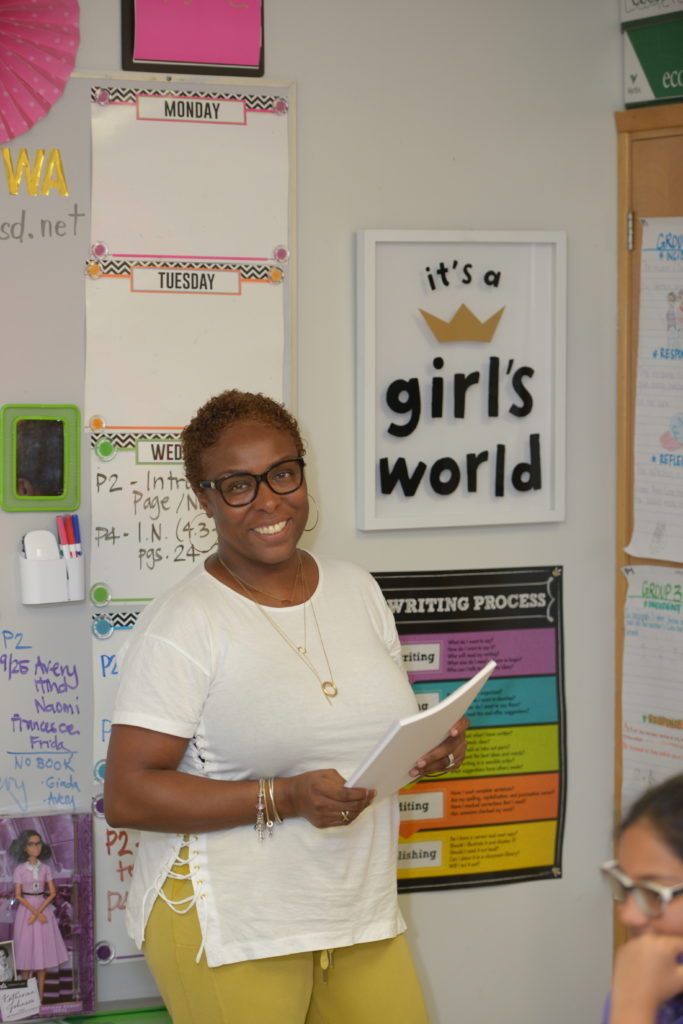
“Research shows that girls begin to deflate in STEM subjects between the ages of 11 and 17. This means that it’s more dire than just potentials not being met — there are girls that aren’t even being given the chance to wonder and dream,” said English teacher Rose Agamegwa. “STEM dreams are normalized, welcomed and nurtured here at GALA.”
The school’s innovative approach to provide girls and women with more opportunity in STEM fields is particularly relevant to equity-related issues in the high-tech industry. These reached a boiling point in November at tech giant Google when more than 20 percent of the workforce walked out in protest of disparate and abusive treatment of women in the workplace, submitting a list of demands that included the ending of pay and opportunity inequities. This organized defiance provided affirmation to girls who dream of careers in coding, computer science and other high-tech fields. It’s almost as if lifetimes of being told “no” and “you can’t” and “girls don’t” have fueled the educators at GALA to tear down all impediments to these opportunities for their students.
“We don’t have barriers to AP classes,” Hicks said. “If you want to take them, we’ll support you.”
This unrestricted access to opportunity has led to some impressive AP enrollment statistics in both STEM and other subjects (see sidebar). And true to the school’s focus on providing tools for girls to be the tech visionaries of tomorrow, 100 percent of 10th-graders take AP Computer Science.
“Before, if I was having a hard time in math class, a lot of the boys wouldn’t respect that. That doesn’t happen here.”
Sachi Hironura, GALA 10th grade student
Today, the 10th-grade girls in that class taught by Jon Landa are giggling while performing math calculations in their heads. One student holds up two playing cards, and the other selects which one is higher based on an identified algorithm. It’s like a coder’s version of the card game Speed, and these girls are fast. The din of noise grows with countless exclamations of “that one” and the slapping of cards onto desktops. The students are enjoying the lesson, to be sure, but it’s also obvious that they like each other. A visit to any classroom at the school reveals an attentive and engaged group of girls working together and supporting one another in the pursuit of knowledge.
“It’s more comfortable than in my past experiences at school,” said GALA 10th-grader Sachi Hironura. “Before, if I was having a hard time in math class, a lot of the boys wouldn’t respect that. That doesn’t happen here.”
‘There’s so much positivity’
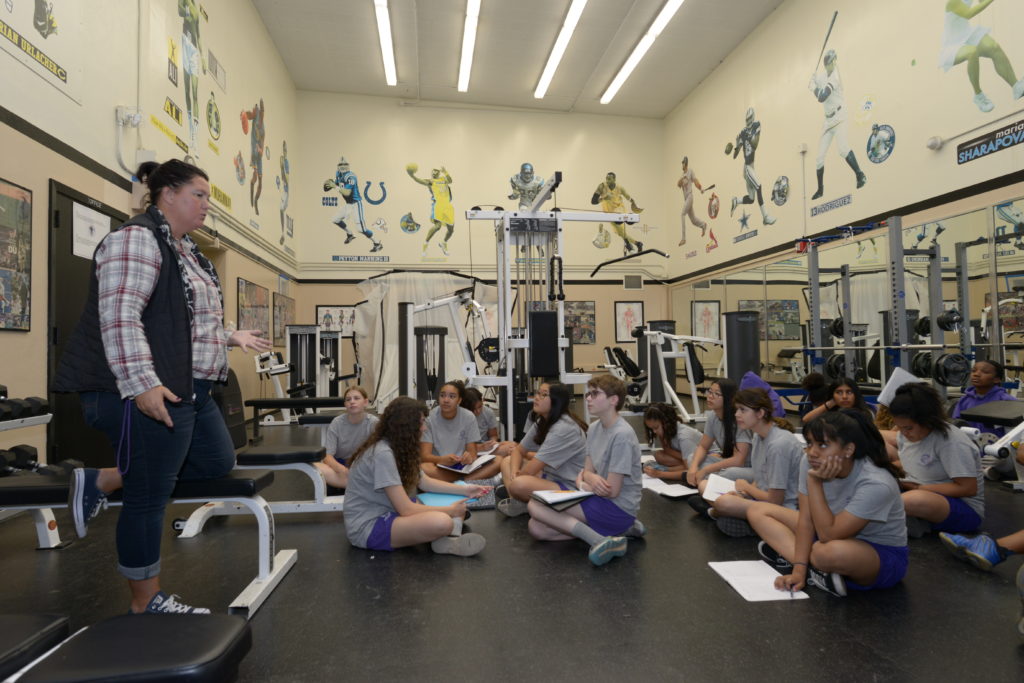
—Johanna Petrich, UTLA
The educators at GALA are nearly all women, most with graduate degrees and all quick to share how teaching at GALA is unique in more than just the obvious ways. Many of the women attended all-girls schools or colleges and are excited for the experience of teaching at one, especially with the freedom and support that Principal Hicks and GALA provide. Hicks recruited the school’s original educators, and the current staff interviews all prospective teachers before anybody new joins the team.
“We have the autonomy to try creative things here,” said McFadden, one of those first teachers that Hicks hired before the school opened. “We’re thinking about who these girls are going to be after high school and beyond. Who are the leaders we are building here?”
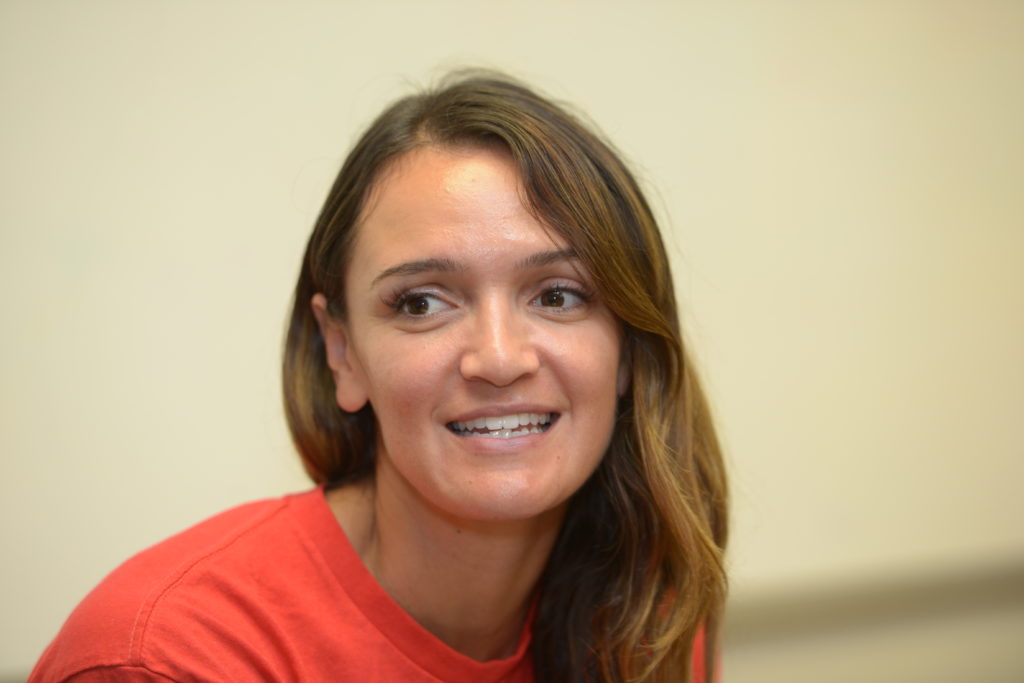
Each student at GALA has an advisory period every day, focused on supporting students’ socio-emotional learning, nurturing their growth as young women, and helping them build self-advocacy and resiliency skills. All GALA students are assigned a teacher as an adviser, who will guide and mentor them from the moment they arrive until they graduate. Tiffany Ragozzino,
a physical education teacher and UTLA member, said the unique environment, focus on opportunity for girls and supportive atmosphere make it a positive place for students and teachers.
“Knowing that there’s a place like GALA that wants to build girls up is amazing,” she said. “It’s the first school I’ve ever worked in that everybody wants to be at, every day.”
Physical education teacher/athletic director Johanna Petrich marches a line of girls in purple shorts and gray T-shirts across the shared Los Angeles High School campus. She opens a door with a small sign above it that reads “Boys Weight Room” and allows entry to the nearly 30 girls. Petrich, a UTLA member, is teaching her students how to use the assorted exercise machines properly and without injuring themselves. She’s passionate about teaching girls to be proactive in their own health routines, and she appreciates the ability to be creative and think outside the box.
“If we have an idea, nobody says we can’t. They say, ‘How can we help you,’” she said. “I like the support I get here to do the things I didn’t think I could do in class. If I want to do something, there is a team here that will help me do it.”
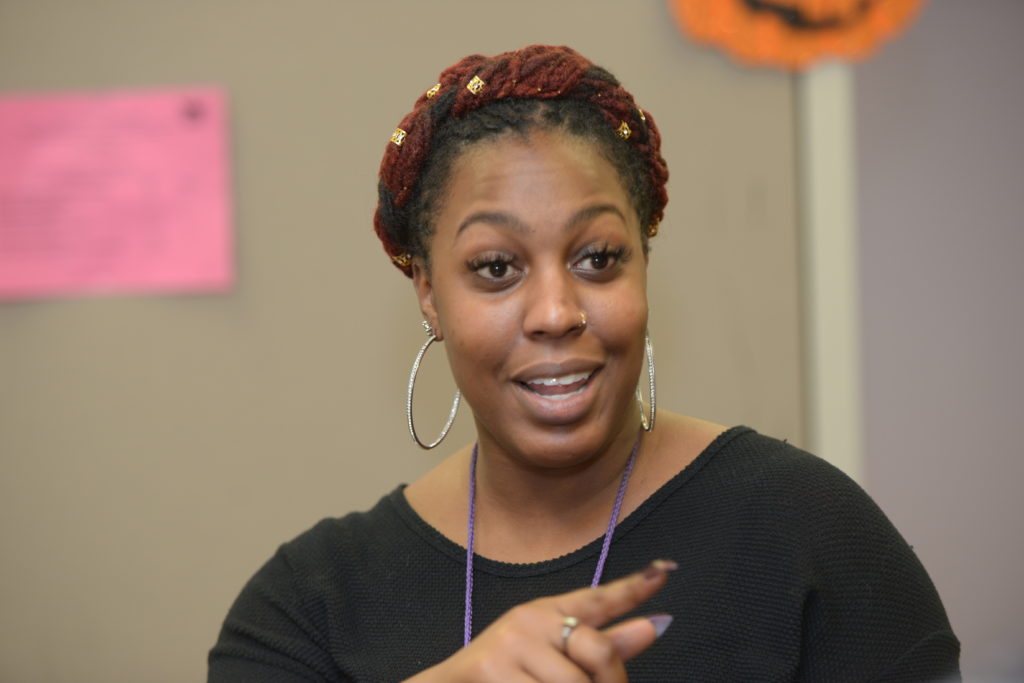
That support doesn’t come only from the educators committed to GALA’s mission. Laila Nur, a seventh-grade math teacher and UTLA member, learned recently about the dedication of the school’s parents. Nur said she wanted to get high-end graphing calculators for each one of her students and started a DonorsChoose account to ask for financial assistance from parents. Nur reported that by the following morning, more than $1,900 had been donated, eclipsing the amount needed to buy the calculators.
It’s very different than what I’m used to. All those crazy ideas I used to have might actually happen now,” she said. “At my other schools, I felt like I wasn’t growing anymore, but now everything I’m doing is about how I can be more innovative. I’m inspired now. I’m not burned out anymore. There’s so much positivity.”
Being in demand has its benefits
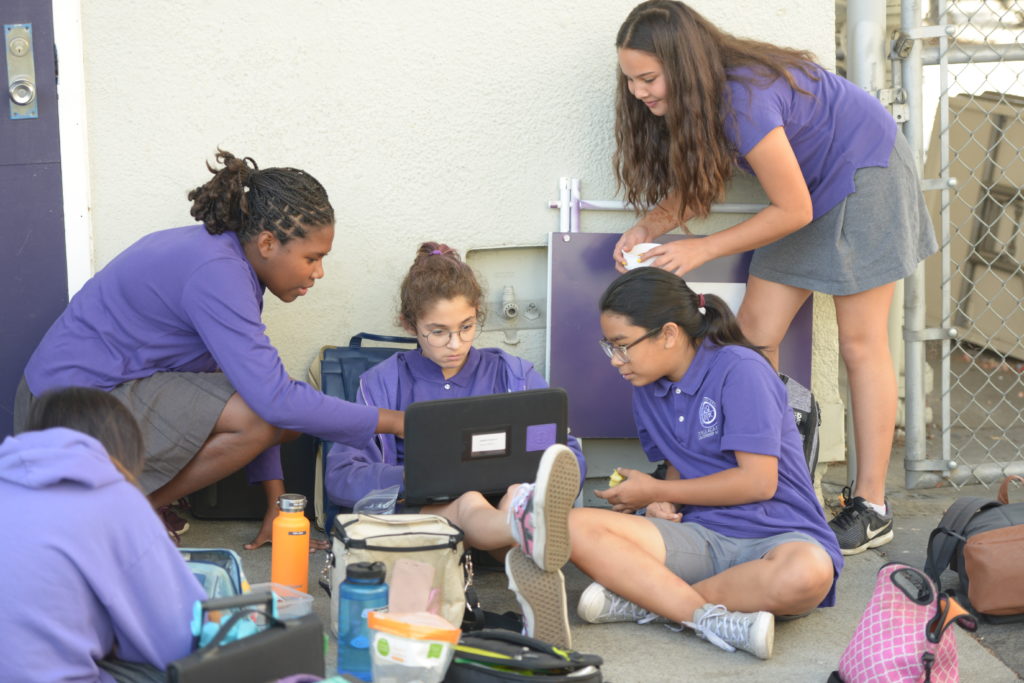
Admission to GALA is granted via a lottery system, and any girl entering sixth grade or later in L.A. Unified can apply for entry — and many, many have. The waiting list is nearly 500 students long, so for the parents of those admitted, it really does feel like they hit the jackpot. Henderson, the Friends of GALA president, said that her daughter, Monica, told her it was either attending GALA or being home-schooled.
Henderson and Claudine Wolas-Shiva, vice president of the parents’ organization, both spoke highly of the dedicated teachers, creative programs and assignments, and the school’s diversity. They mentioned student-driven learning opportunities, such as
a model United Nations and reading with dogs, and inspiring experiences and relationships with accomplished women aerospace engineers and programmers. As a woman in tech herself, Wolas-Shiva said she wanted to give her two daughters, Laila and Taiya, opportunities in STEM that she had to seek out. She also wanted an environment that would teach them to be strong and advocate for themselves.
“I have been a woman in tech. I have faced unconscious bias. I have had experiences that I don’t want my children to go through,” she said. “I wanted to give them a chance to step out of STEM instead of having to step into STEM.”
The popularity of GALA, its special atmosphere and its wealth of opportunities have had an unintended benefit for L.A. Unified: In the three years since GALA opened, 190 students have been admitted who had previously attended private schools or independent charters. This means more than $2.5 million in state funding returning to L.A. Unified and greater resources for all the district’s students.
A Senator stands up for the special school

State Sen. Holly Mitchell (D-Los Angeles) has always had a penchant for fighting for equitable opportunity for girls and women, and when she met Principal Hicks in 2015, she was immediately supportive of the school and its unique mission. But there was one big problem: the all-girls public school was in violation of state law prohibiting single-gender public schools. While GALA conformed with Title IX, which contains an amendment allowing single-gender schools, it was not in compliance with state law, which differed from the federal law prohibiting discrimination in public schools on the basis of gender.
Mitchell immediately got behind a pending bill by Assemblyman Sebastian Ridley-Thomas (D-Los Angeles) that would align state and federal laws to allow single-gender academies like GALA in (and only in) LAUSD. Despite organized opposition to the bill, Mitchell was able to usher it through the state Senate after the bill garnered approval in the Assembly, inviting Hicks and some of GALA’s students to join her on the Senate floor during her final call to support it. Assembly Bill 23 passed and was signed into law, and Mitchell is thrilled with the result.
“Creating opportunity for children and girls where they don’t routinely have it is a passion of mine. We’re impacting the child poverty rate by providing resources for girls to enter these emerging industries,” Mitchell said. “Gender bias is real, and once we confront it directly, we’ll be in a better position to have a meaningful conversation about how we can change it.”
Mitchell plans outings every year with GALA’s ninth-grade girls to give them exposure to women working in high-tech fields in the real world. She breaks into a big smile as she talks about the promise and enthusiasm in GALA girls, proclaiming that “they know they’re our future, and they’re ready.” Physics teacher Hill said that Mitchell’s support means a lot to the girls, whether its taking field trips to see the inner workings of the Culver City transportation system or helping the senator celebrate women and girls in STEM in the state Capitol.
“Knowing that Sen. Mitchell is connected to our school makes the girls feel special,” Hill said. “She’s a role model to them.”
Colleges come calling for GALA girls
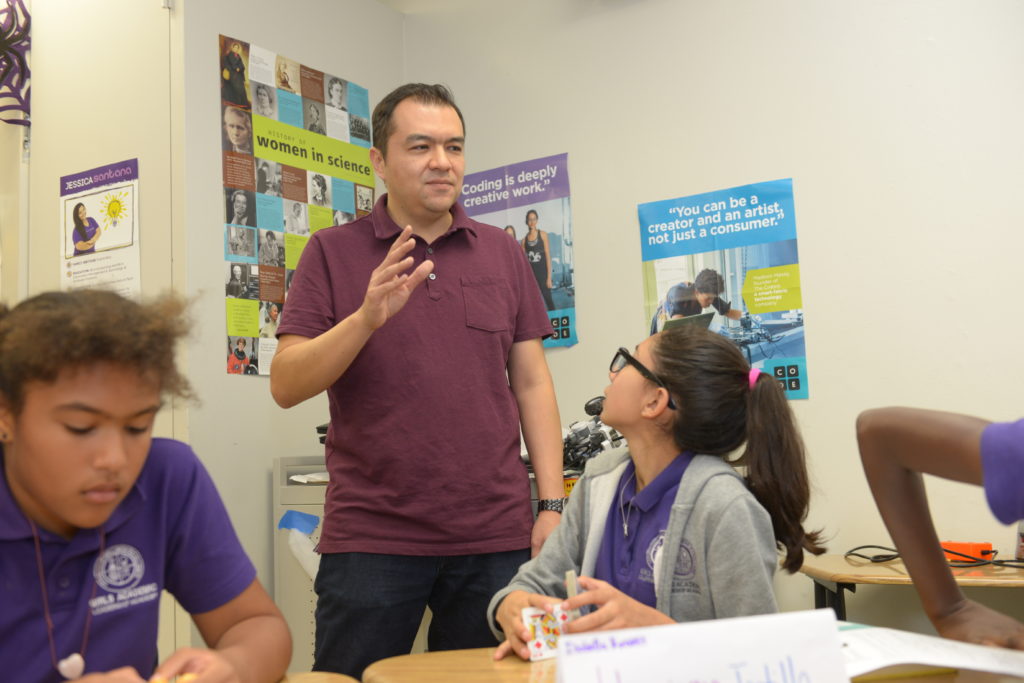
The diverse group of 11th-grade girls who excel in STEM subjects is now catching the attention of higher learning institutions. Hicks said prestigious schools like Massachusetts Institute of Technology and Denison University are already scheduled to visit. A school full of students who’ve taken AP Computer Science is a rarity anywhere in the country, and girls of color who’ve done so are even more scarce.
“I’m so excited for them. They’re going to be attending colleges all over the country,” Hicks said.
GALA’s popularity has already spurred an all-boys public equivalent in LAUSD — the Boys Academic Leadership Academy of Los Angeles, also founded by the visionary Hicks. While the verdict on whether the special environment at GALA translates into achievement is still out until the school graduates its first class, initial assessment scores for math and science in sixth and seventh grades are off the charts — more than double the districtwide proficiency rate. And the educators there say their girls wouldn’t remain silent if they felt their experience didn’t live up to their expectations.
“I have girls that are so eloquent about their needs and desires,” Nur said. “They have a vision.”
GALA by the Numbers
Grades: 6–11 (6–12 in 2020, when first class graduates)
Educators: 22
Administrators: 1
Students: 490
Ethnicity:
• 32% Latina
• 28% White
• 22% African-American
• 11% Asian
• 7% Other
Advanced Placement enrollment (at grade levels):
• AP Biology: 55% of 9th
• AP Chemistry: 37% of 10th
• AP Computer Science: 100% of 10th
• AP Physics: 100% of 11th
• AP English Language: 67% 11th
• AP World History: 62% of 10th
• AP U.S. History: 43% of 11th
• AP Seminar: 67% of 11th
Note: Only 70 girls of color statewide took AP Seminar in 2017–18
The Discussion 0 comments Post a Comment